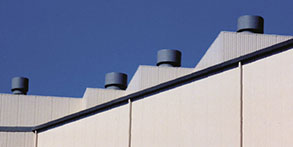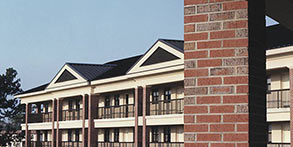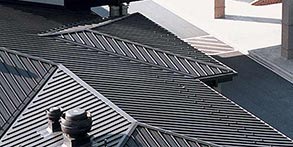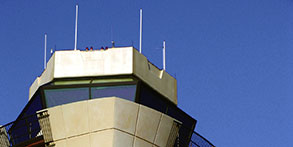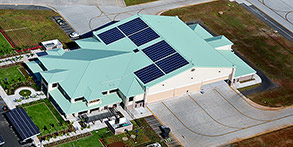- Minimize and consolidate roof penetrations into a single, inconspicuous point whenever possible.
- Clad pipe penetrations to match the roofing material.
- Avoid the use of rooftop mechanical equipment, however for renovations and unavoidable configurations ensure units are screened.
- Provide access points and service routes to equipment that protect the roof.
- Screen all large vents.
- Ensure attic spaces are properly vented at ridges and soffits.
- Match roof color for all exposed equipment and vents.
- Avoid roof-mounted antenna systems.
- Arrange Lightning Protection Systems (LPS) components in an ordered, uncluttered, inconspicuous appearance and integrated into the organization of the roof and wall systems.
- Ensure that LPS roof mounting systems are approved by the roofing manufacturer.
- Additions to a roof will not interfere with LPS or other rooftop systems that may be required.
- Permanent fall protection will be included with any addition to a roof with a slope above 3:12 per UFC 3-110-03.
Design and construct roof systems to shed water and shade walls and openings. Use their reflectance to reduce heat transfer. Select roof materials that will not show excessive weathering or wear during their typical life span.
Roof color, material and form are prominent features and play a significant role in architectural compatibility. Ensure visible roof systems are comparable in shape, slope, material and color on an installation and follow Installation Facilities Standards (IFS) and requirements for the Facility Group.
Coordinate and integrate roof and wall systems to ensure that individual elements have an uncluttered, organized appearance. Avoid overly complicated solutions and combination of multiple styles, forms and types on a facility.
Sustainability
Roofing systems must contribute to the mitigation of heat island effect and provide a Solar Reflectance Index (SRI) as outlined in these standards. When life cycle cost effective and allowed by law, design roof systems with full integration of rainwater collection, non-potable irrigation and stormwater systems.
Following the directives of UFC 1-200-02, evaluate the life-cycle cost effectiveness of “passive” building components that provide shading, such as roof overhangs and fixed shading grilles, meshes and screens.
Resilience
Provide engineered designs in response to documented risks associated with high winds, hurricanes and typhoons for all roof materials and detailing. Consider the design of overhangs and roof features such as clerestories, dormers and parapets when selecting roof materials and detailing roof systems.
UFC 1-200-01 General Building Requirements https://www.wbdg.org/dod/ufc/ufc-1-200-01
UFC 1-200-02 High Performance and Sustainable Building Requirements https://www.wbdg.org/dod/ufc/ufc-1-200-02
UFC 3-101-01 Architecture https://www.wbdg.org/dod/ufc/ufc-3-101-01
UFC 3-110-03 Roofing https://www.wbdg.org/dod/ufc/ufc-3-110-03
UFC 3-110-04 Roofing Maintenance and Repair https://www.wbdg.org/dod/ufc/ufc-3-110-04
UFC 3-210-10 Low Impact Development https://www.wbdg.org/dod/ufc/ufc-3-210-10
UFC 3-575-01 Lightning and Static Electricity Protection Systems https://www.wbdg.org/dod/ufc/ufc-3-575-01
UFC 4-010-01 DoD Minimum Antiterrorism Standards for Buildings https://www.wbdg.org/dod/ufc/ufc-4-010-01
AFI 32-1051 Roof Systems Management https://static.e-publishing.af.mil/production/1/af_a4/publication/afi32-1051/afi32-1051.pdf
ETL 08-10 Alternative Water Sources – Use of Non-Potable Water https://www.wbdg.org/FFC/AF/AFETL/etl_08_10.pdf

